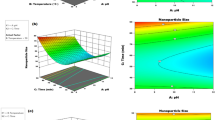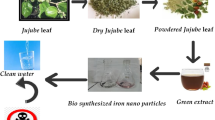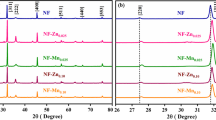Abstract
Contamination of potable water supplies will in the future lead to the emergence of problems like lack of water. Therefore, the issues such as environmental pollution and the purification of water have been a major focus of scientists recently. Especially, the removal of the heavy metals and organic substances that are harmful to human health and exist in industrial waste water is of great importance. In this study, removal of textile dye (Maxilon® Blue GRL 300%, MBG), which is a significant impurity, from water was carried out by using iron oxide nanoparticles. Iron oxide nanoparticles were synthesized by using co-precipitation method. XRD, SEM, TEM, size distribution, zeta potential and magnetic properties measurements were performed to investigate the properties of the nanoparticles. The MBG removal capacities of iron oxide nanoparticles were investigated by taking into account the initial metal ion concentration, pH of aqueous medium, time and temperature. The dye adsorption capacity of iron oxide nanoparticles increased with an increase in dye concentration and temperature. The highest dye removal was observed at pH 9.0. According to the evaluation of the dye concentration effect on adsorption process, when the highest concentration of 25.0 mg/L dye solution was used at room temperature, the highest dye adsorption capacity was determined as 0.23 mg/g. The results of adsorption kinetics and thermodynamic data have shown that adsorption process has pseudo-second-order kinetics and endothermic form. Adsorption studies data have well fitted to Langmuir isotherm at room temperature.













Similar content being viewed by others
References
Akın D, Yakar A, Gündüz U (2015) Synthesis of magnetic Fe3O4-chitosan nanoparticles by ionic gelation and their dye removal ability. Water Environ Res 87:425–436
Aljeboree AM, Radi N, Ahmed Z, ve Alkaim AF (2014) The use of sawdust as by product adsorbent of organic pollutant from wastewater: adsorption of maxilon blue dye. Int J Chem Sci 12(4):1239–1252
Alkaim AF, Sadik Z, Mahdi DK, Alshrefi SM, Al-Sammarraie AM, Alamgir FM, Singh PM, Aljeboree AM (2015) Preparation, structure and adsorption properties of synthesized multiwall carbon nanotubes for highly effective removal of maxilon blue dye. Korean J Chem Eng 32:2456–2462
Banat F, Al-Asheh S, Al-Makhedmeh L (2003) Evaluation of the use of raw and activated date pits as potential adsorbents for dye containing waters. Process Biochem 39:193–202
Baumgartner J, Bertinetti L, Widdrat M, Hirt AM, Faivre D (2013) Formation of magnetite nanoparticles at low temperature: from superparamagnetic to stable single domain particles. PLoS ONE 8(3):e57070. https://doi.org/10.1371/journal.pone.0057070
Behnajady MA, Yavari S, Modirshahla N (2014) Investigation on adsorption capacity of TiO2-P25 nanoparticles in the removal of a mono-azo dye from aqueous solution: a comprehensive isotherm analysis. Chem Ind Chem 20:97–107
Boparai HK, Joseph M, O’Carroll DM (2011) Kinetics and thermodynamics of cadmium ion removal by adsorption onto nano zerovalent iron particles. J Hazard Mater 186:458–465
Broomberg J, Gelinas S, Finch JA, Xu Z (1999) Review of magnetic carrier technologies for metal ion removal. Magn Electr Sep 9:169–188
Doğan M, Alkan M, Demirbas Ö, Özdemir Y, Özmetin C (2006) Adsorption kinetics of maxilon blue GRL onto sepiolite from aqueous solutions. Chem Eng J 124:89–101
Dönmez G, Aksu Z (2002) Removal of chromium(VI) from saline wastewaters by Dunaliella species. Process Biochem 38:751–762
Freundlich H (1926) Colloid and capillary chemistry. Methuen, London, p 39
Gao H, Zhao S, Cheng X, Wang X, Zheng L (2013) Removal of anionic azo dyes from aqueous solution using magnetic polymer multi-wall carbon nanotube nanocomposite as adsorbent. Chem Eng J 223:84–90
Ge F, Ye H, Li MM, Zhao BX (2012) Efficient removal of cationic dyes from aqueous solution by polymer-modified magnetic nanoparticles. Chem Eng J 198–199:11–17
Ghandoor HE, Zidan HM, Khalil MMH, Ismail MIM (2012) Synthesis and some physical properties of magnetite (Fe3O4) nanoparticles. Int J Electrochem Sci 7:5734–5745
Gnanaprakash G, Mahadevan S, Jayakumar T, Kalyanasundaram P, Philip J, Raj B (2007) Effect of initial pH and temperature of iron salt solutions on formation of magnetite nanoparticles. Mater Chem Phys 103:168–175
Gnanaprakash G, Philip J, Jayakumar T, Raj B (2007) Effect of digestion time and alkali addition rate on physical properties of magnetite nanoparticles. J Phys Chem 111:7978–7986
Hariani PL, Faizal M, Marsi R, Setiabudidaya D (2013) Synthesis and properties of Fe3O4 nanoparticles by co-precipitation method to removal procion dye. IJESD 4:336–340
Ho YS, Chiang TH, Hsuesh YM (2005) Removal of basic dye from aqueous solution using tree fern as a biosorbent. Process Biochem 40:119–124
Huang YH, Hsueh CL, Huang CP, Su LC, Chen CY (2007) Adsorption thermodynamic and kinetic studies of Pb(II) removal from water onto a versatile Al2O3-supported iron oxide. Sep Purif Technol 55:23–29
Jadhav SA, Patil SV (2014) Facile synthesis of magnetic iron oxide nanoparticles and their characterization. Front Mater Sci 8:193–198
Juang RS, Wu FC, Tseng RL (1997) The ability of activated clay for the adsorption of dyes from aqueous solutions. Environ Technol 18:525–531
Khosravi M, Azizian S (2014) Adsorption of anionic dyes from aqueous solution by iron oxide nanospheres. J Ind Eng Chem 20:2561–2567
Kim DK, Zhang Y, Voit W, Rao KV, Muhammed M (2001) Synthesis and characterization of surfactant-coated superparamagnetic monodispersed iron oxide nanoparticles. J Magn Magn Mater 225:30–36
Langmuir I (1918) The adsorption of gases on plane surfaces of glass, mica and platinum. J Am Chem Soc 40:1361–1403
Li L, Duan H, Wang X, Luo C (2015) Fabrication of novel magnetic nanocomposite with a number of adsorption sites for the removal of dye. Int J Biol Macromol 78:17–22
Lillo-Rodenas MA, Marco-Lozar JP, Cazorla-Amoros D, Linares-Solano A (2007) Activated carbons prepared by pyrolysis of mixtures of carbon precursor/alkaline hydroxide. J Anal Appl Pyrol 80:166–174
Lin CC, Lin YS, Ho YM (2016) Adsorption of Reactive Red 2 from aqueous solutions using Fe3O4 nanoparticles prepared by co-precipitation in a rotating packed bed. J Alloy Compd 666:153–158
Madrakian T, Afkhami A, Kashani HM, Ahmadi M (2013) Adsorption of some cationic and anionic dyes on magnetite nanoparticles-modified activated carbon from aqueous solutions: equilibrium and kinetics study. J Iran Chem Soc 10:481–489
Madrakian T, Afkhami A, Zolfigol MA, Ahmadi M, Koukabi N (2012) Application of modified silica coated magnetite nanoparticles for removal of iodine from water samples. Nano Micro Lett 4:57–63
Mascolo MC, Pei Y, Ring TA (2013) Room temperature co-precipitation synthesis of magnetite nanoparticles in a large pH window with different bases. Materials 6:5549–5567
Monshi A, Foroughi MR, Monshi MR (2012) Modified Scherrer equation to estimate more accurately nano-crystallite size using XRD. WJNSE 2:154–160
Namasivayam C, Radhika R, Suba S (2001) Uptake of dyes by a promising locally available agricultural solid waste: coir pith. Waste Manag 21:381–387
Nas MS (2019) The investigation of thermodynamics parameters and adsorption kinetic of the maxilon blue 5G dye on Turkey green clay. Iğdır Üniv Fen Bilim Enst Derg 9:749–758
Shao H, Yoon TJ, Liong M, Weissleder R, Lee H (2010) Magnetic nanoparticles for biomedical NMR-based diagnostics. Beilstein J Nanotechnol 1:142–154
Shen L, Qiao Y, Guon Y, Meng S, Yang G (2014) Facile co-precipitation synthesis of shape-controlled magnetite nanoparticles. Ceram Int 40:1519–1524
Sivashankar R, Sathya AB, Vasantharaj K, Sivasubramanian V (2014) Magnetic composite an environmental super adsorbent for dye sequestration. Environ Nanotechnol Monit Manag 1–2:36–49
Song W, Gao B, Xu X, Xing L, Han S, Duan P, Song W, Jia R (2016) Adsorption–desorption behavior of magnetic amine/Fe3O4 functionalized biopolymer resin towards anionic dyes from wastewater. Bioresour Technol. https://doi.org/10.1016/j.biortech.2016.01.078
Stephen Inbaraja B, Chen BH (2011) Dye adsorption characteristics of magnetite nanoparticles coated with a biopolymer poly(γ-glutamic acid). Bioresour Technol 102:8868–8876
Temkin MJ, Pyzhev V (1940) Kinetics of ammonia synthesis on promoted iron catalysts. Acta Physicochitnica URSS 12:217–222
Wang B, Wei Q, Qu S (2013) Synthesis and characterization of uniform and crystalline magnetite nanoparticles via oxidation-precipitation and modified co-precipitation methods. Int J Electrochem Sci 8:3786–3793
Weber WJ, Smith EH (1987) Simulation and design models for adsorption processes. Environ Sci Technol 21:1040–1050
Yakar A, Tansık G, Keskin T, Gündüz U (2013) Tailoring the magnetic behavior of polymeric particles for bioapplications. J Polym Eng 33:265–274
Yao T, Guo S, Zeng C, Wang C, Zhang L (2015) Investigation on efficient adsorption of cationic dyes on porous magnetic polyacrylamide microspheres. J Hazard Mater 292:90–97
Yuan X, Zhuo SP, Xing W, Cui HY, Dai XD, Liu XM, Yan ZF (2007) Aqueous dye adsorption on ordered mesoporous carbons. J Colloid Interface Sci 310:83–89
Zhao S, Asuha S (2010) One-pot synthesis of magnetite nanopowder and their magneticproperties. Powder Technol 197:295–297
Zheng H, Liu D, Zheng Y, Liang S, Liu Z (2009) Sorption isotherm and kinetic modeling of aniline on Cr-bentonite. J Hazard Mater 167:141–147
Zhou Z, Lin S, Yue T, Lee TC (2014) Adsorption of food dyes from aqueous solution by glutaraldehyde cross-linked magnetic chitosan nanoparticles. J Food Eng 126:133–141
Acknowledgements
This study was supported by TUBITAK (1139B411500163). The authors would like to thank Mahfus Doğan, Ozan Aslan and Ömer Özbek for their contributions. The authors would like to thank METU Central Laboratory and TUAM at Afyon Kocatepe University for all characterization analyses and to thank Bilimteks Company.
Author information
Authors and Affiliations
Corresponding author
Additional information
Publisher's Note
Springer Nature remains neutral with regard to jurisdictional claims in published maps and institutional affiliations.
Rights and permissions
About this article
Cite this article
Yakar, A., Ünlü, A., Yeşilçayır, T. et al. Kinetics and thermodynamics of textile dye removal by adsorption onto iron oxide nanoparticles. Nanotechnol. Environ. Eng. 5, 6 (2020). https://doi.org/10.1007/s41204-020-0068-0
Received:
Accepted:
Published:
DOI: https://doi.org/10.1007/s41204-020-0068-0




